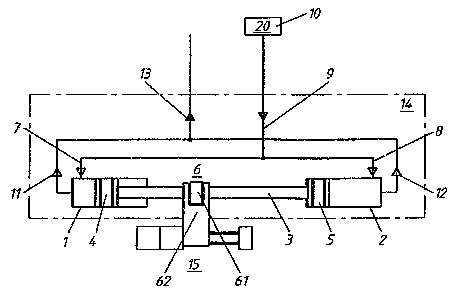Some of the information on this Web page has been provided by external sources. The Government of Canada is not responsible for the accuracy, reliability or currency of the information supplied by external sources. Users wishing to rely upon this information should consult directly with the source of the information. Content provided by external sources is not subject to official languages, privacy and accessibility requirements.
Any discrepancies in the text and image of the Claims and Abstract are due to differing posting times. Text of the Claims and Abstract are posted:
| (12) Patent: | (11) CA 2123161 |
|---|---|
| (54) English Title: | DOUBLE-PISTON PUMP FOR ADMINISTERING MEDICATION |
| (54) French Title: | POMPE A PISTON DOUBLE POUR L'ADMINISTRATION DE MEDICAMENT |
| Status: | Term Expired - Post Grant Beyond Limit |
| (51) International Patent Classification (IPC): |
|
|---|---|
| (72) Inventors : |
|
| (73) Owners : |
|
| (71) Applicants : |
|
| (74) Agent: | MARKS & CLERK |
| (74) Associate agent: | |
| (45) Issued: | 2005-03-15 |
| (22) Filed Date: | 1994-05-09 |
| (41) Open to Public Inspection: | 1994-11-11 |
| Examination requested: | 2000-05-02 |
| Availability of licence: | N/A |
| Dedicated to the Public: | N/A |
| (25) Language of filing: | English |
| Patent Cooperation Treaty (PCT): | No |
|---|
| (30) Application Priority Data: | ||||||
|---|---|---|---|---|---|---|
|
The device of the invention provides preselected doses of liquid medicine and has a cylinder assembly (1, 2) with a left cylinder (1), a right cylinder (2) and a double piston (4, 5) displaceably mounted in the assembly with a left piston end (4) and a right piston end (5). A coupling links the double piston in a positive and/or frictional manner with a drive unit (15). The device is controlled passively by two automatically closing intake valves (7, 8) and two discharge valves (11, 12). Thereby a continuous flow of liquid medicine 20 out of the medicine container 10 can be generated.
Le dispositif de l'invention fournit des doses présélectionnées de médicaments liquides et possède un ensemble de cylindre (1, 2) avec un cylindre gauche (1), un cylindre droit (2) et un double piston (4, 5) montés de manière déplaçable dans l'ensemble avec une extrémité gauche du piston (4) et une extrémité de piston droite (5). Un accouplement relie le double piston d'une manière positive et/ou par friction avec une unité d'entraînement (15). Le dispositif est contrôlé passivement par deux soupapes d'admission à fermeture automatique (7, 8) et deux soupapes de décharge (11, 12). De ce fait un flux continu d'un médicament liquide 20 du récipient 10 à médicament peut être généré.
Note: Claims are shown in the official language in which they were submitted.
Note: Descriptions are shown in the official language in which they were submitted.

2024-08-01:As part of the Next Generation Patents (NGP) transition, the Canadian Patents Database (CPD) now contains a more detailed Event History, which replicates the Event Log of our new back-office solution.
Please note that "Inactive:" events refers to events no longer in use in our new back-office solution.
For a clearer understanding of the status of the application/patent presented on this page, the site Disclaimer , as well as the definitions for Patent , Event History , Maintenance Fee and Payment History should be consulted.
| Description | Date |
|---|---|
| Inactive: Expired (new Act pat) | 2014-05-09 |
| Inactive: IPC from MCD | 2006-03-11 |
| Inactive: IPC from MCD | 2006-03-11 |
| Inactive: IPC from MCD | 2006-03-11 |
| Grant by Issuance | 2005-03-15 |
| Inactive: Cover page published | 2005-03-14 |
| Pre-grant | 2004-12-16 |
| Inactive: Final fee received | 2004-12-16 |
| Notice of Allowance is Issued | 2004-09-27 |
| Notice of Allowance is Issued | 2004-09-27 |
| Letter Sent | 2004-09-27 |
| Inactive: Approved for allowance (AFA) | 2004-09-15 |
| Amendment Received - Voluntary Amendment | 2004-05-31 |
| Inactive: S.29 Rules - Examiner requisition | 2003-12-02 |
| Inactive: S.30(2) Rules - Examiner requisition | 2003-12-02 |
| Amendment Received - Voluntary Amendment | 2000-10-31 |
| Letter Sent | 2000-05-15 |
| Inactive: Status info is complete as of Log entry date | 2000-05-15 |
| Inactive: Application prosecuted on TS as of Log entry date | 2000-05-15 |
| All Requirements for Examination Determined Compliant | 2000-05-02 |
| Request for Examination Requirements Determined Compliant | 2000-05-02 |
| Application Published (Open to Public Inspection) | 1994-11-11 |
There is no abandonment history.
The last payment was received on 2004-04-19
Note : If the full payment has not been received on or before the date indicated, a further fee may be required which may be one of the following
Patent fees are adjusted on the 1st of January every year. The amounts above are the current amounts if received by December 31 of the current year.
Please refer to the CIPO
Patent Fees
web page to see all current fee amounts.
Note: Records showing the ownership history in alphabetical order.
| Current Owners on Record |
|---|
| MEDIMPEX ETS. |
| Past Owners on Record |
|---|
| HEINZ HUGGENBERGER |